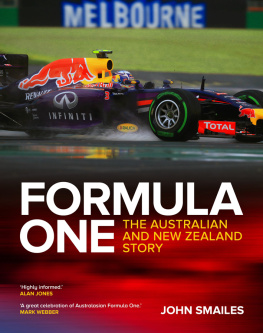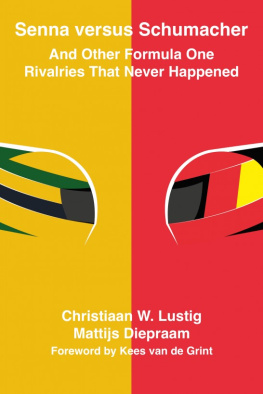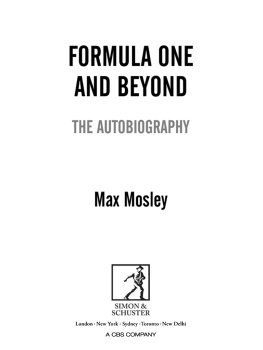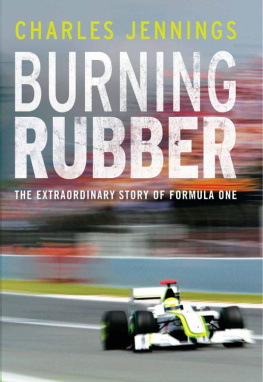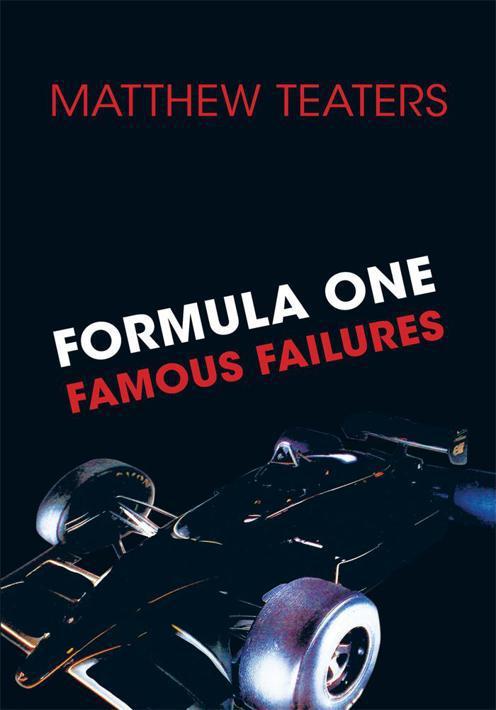FORMULA ONE
FAMOUS FAILURES
Matthew Teaters
Order this book online at
Most Trafford titles are also available at major online book retailers.
Copyright 2011 Matthew Teaters.
All rights reserved. No part of this publication may be reproduced, stored in a retrieval system, or transmitted, in any form or by any means, electronic, mechanical, photocopying, recording, or otherwise, without the written prior permission of the author.
Edited by Matthew Teaters.
Cover Design/Artwork by Vanessa Teaters.
Photography by Vanessa Teaters.
Note for Librarians: A cataloguing record for this book is available from Library and Archives Canada at www.collectionscanada.ca/amicus/index-e.html
Printed in the United States of America.
isBN: 978-1-4251-8528-2 (sc)
ISBN: 978-1-4269-7966-8 (ebook)
Trafford Rev. date: 06/27/2011
www.trafford.com
North America & international
toll-free: 1 888 232 4444 (USA & Canada)
phone: 250 383 6864 fax: 250 383 6804 email:
The United Kingdom & Europe
phone: +44 (0)1865 487 395 local rate: 0845 230 9601 facsimile: +44 (0)1865 481 507 email:
10 9 8 7 6 5 4 3 2
Contents
April 5, 1982-December 10,2004
Matthew was sick from the first day he was born. Even though he suffered all his life he dedicated his life to taking care of others. He was a wonderful Christian and never met a stranger. He was always going to church, visiting the sick in hospitals in nursing homes and helping anyone that he could. His greatest loves were the Lord and racing. He taught himself to read by reading racing magazines and loved every minute of it. Matthew wrote for a Formula One Column on the internet. His great love is this book. We hope you will enjoy reading the book as much as he enjoyed writing it. He put his whole heart into it. Even though he suffered his whole life he was on the national deans list for his writing.
He was our hero and will always be. He was taken from us so early in life but the Lord needed him more.
Please enjoy his book for his memory. We just wish he could have known how much it pleased others.
We love and miss him, Your family
Created in 1950, the Formula One World Championship is the pinnacle of auto racing. The most popular form of motor sports on Earth, some of its marquee teams are known throughout the world, such as Ferrari, McLaren, and Lotus. Formula Ones glamorous outlook and incredible marketing power make one believe that it is a fantasy world of expensive machinery and super hero drivers, a dazzling array of lines and colors. But if one looks closer into the history of the world Championship, one will notice another side to Formula one, a side of failure. It is obvious that not every car can be a Lotus 49 or a Williams FW 14B. And not every engine can have the impact of a Ford Cosworth DFV or a Honda turbo, in fact very few are, but some stand out as some of Formula Ones most famous failures. What are the worst? That is certainly open to debate. Each year, for every winner, there are numerous disappointments, but this novel hopes to illustrate the fights and famines of the Grand Prix World.
Chassis: Ferrari 166T
Engine: Jaguar XK in-line 6, 3.4-liter normal aspiration
Best Result: DNF (Biondetti, Italy)
THE 2000 SEASON is generally regarded as the first time that a Formula One car bearing the name Jaguar has taken its place on the grid. That is not totally true, for in 1950, Clemente Biondetti took a Jaguar engine derived from Le Mans and matted it with his Ferrari. The ultimate odd couple, indeed.
Clemente Biondetti had a rather successful racing career leading up to the break in motorsports caused by World War II. He won the famous Mille Miglia in an Alfa Romeo 2900B and after the end of World War II, he again won the prestigious Italian road race in 1947, again in Alfa Romeo 2900B. He then went on to win two more Mille Miglias in 1948 and 49, both times driving for Ferrari.
By 1950, he was driving for Jaguar in a C-type at Le Mans when at the same time; the Formula One Championship had been formed. Eager to compete in his home Grand Prix in Italy, Biondettihe lifted the Jaguar XK engine and gearbox out of the Jaguar and put it in the Ferrari 166T (which was most likely from the basis of a Maserati) that he owned. Also borrowed from the Jaguar were the gearbox, front suspension, brakes, and transmission. With these modifications, Biondetti created the odd Ferrari-Jaguar. The entrant bore his own name, and the organizers gave him the number 22.
He qualified 25 th out of the 27 starters, but Paul Pietschs Maseratis didnt record a qualifying time so he was actually next to slowest, in front of the Maserati/Milano of Franco Comotti. He was also 32 seconds off the pole time of Juan Manual Fangio in the Alfa Romeo.
Biondetti lasted only 17 laps before the Jaguar left him down. Disappointed, he would never again attempt a Grand Prix. The Ferrari-Jaguar would be revamped with bodywork from a Spider Corsa and raced in sports cars. Biondetti then went back to the Jaguar Mille Miglia effort, before giving that up to race for Ferrari in sports cars. Biondetti finished fourth in his final Mille Miglia effort while driving for Ferrari in 1954 and would retire from racing to concentrate on battling cancer, for which he was suffering from.
Cancer claimed his life on February 24 th , 1955. He was 56 years old. But he is responsible for Jaguars first venture into Formula One, although it was hardly a Jaguar project.
Chassis: Lancia D50
Engine: Lancia DS50 V8, 2.5-liter normal aspiration
Best Result: 2nd (Castellotti, Monaco)
LOST POTENTIAL. PERHAPS that is the best way to describe
the Lancia F1 project. The Lancia D50 had undoubted speed, top drivers, and a good team. So what went wrong? A combination of tragedy and economics put an end to the program in 1955, but the cars themselves would see more glory in the future under the Scuderia Ferrari.
Vincenzo Lancia had started a small, Italian car company in 1906 and yet had not seriously entered a dedicated project in motorsport, instead finding it more important to concentrate on the production car market. When he died the company was left to his son, Gianni, who did have aspirations to have the company involved in motor-sports. Soon the beautiful and revolutionary Aurelia Grand Turismo sports car was hitting the tracks with its in-board rear brakes and production spec V6 engine.
But Lanica had one eye on Formula One. And soon a Lanica would be built to compete on the Grand Prix circuits. Despite Lancia being a generally small company, their Formula One effort was to be first class. Vittorio Jano had joined the company in 1937 and would oversee the work done on the F1 car, dubbed the D50. The D50 had many innovative features. For one, it was one the first Grand Prix car to use the engine as a stressed member of the chassis. This meant that instead of simply being dropped into the car, it would now become a load-bearing member of the chassis, with only a tubular frame running underneath the engine, as the car would virtually fall apart when the engine was removed! The engine that would demonstrate this technique would be Lancias DS50 90-degree 2.5-liter V8, which produced approximately 250 horsepower at 8,100 RPMs using dual overhead camshafts. It was also fitted into the D50 at an angle with the propeller shaft directed to the left of the driver using transaxle input gears. Another aspect of the car that was innovative was its twin fuel tanks that ran down the sides of the machine in-between the wheels. This concept would allow for better weight distribution during the races when fuel was being consumed. In addition, it also helped to clean up the dirty air that existed between the wheels. The car featured a five-speed gearbox and was very light in comparison with many of its competitors, weighing in at a reputed 620 kilograms. In keeping with the Italian theme, tires were supplied by the Pirelli company. The team had also made headlines by signing the legendary Alberto Ascari away from Ferrari, who officially signed on January 1 st , 1954, to drive for the team.


